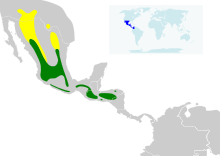Painted redstart
| Painted redstart | |
|---|---|

| |
| Scientific classification | |
| Domain: | Eukaryota |
| Kingdom: | Animalia |
| Phylum: | Chordata |
| Class: | Aves |
| Order: | Passeriformes |
| Family: | Parulidae |
| Genus: | Myioborus |
| Species: | M. pictus
|
| Binomial name | |
| Myioborus pictus (Swainson, 1829)
| |

| |
| Range of M. pictus Breeding range Year-round range
| |
| Synonyms | |
|
Setophaga pictus | |
The painted redstart or painted whitestart (Myioborus pictus) is a species of New World warbler found in mountainous areas across inland Central America. They are among the largest warblers, reaching the length of 6 inches (150 mm), tail included. Adult birds have glossy black plumage, with white strips on the wing and a bright red belly. Female and male birds have similar appearance. Female painted redstarts have a rare feature of being as good singers as the males.
Taxonomy
When he first described the species in 1829, naturalist
There are two subspecies, which differ only slightly in appearance:[7][8]
- M. p. pictus is found from Arizona and New Mexico in the southern United States to Oaxaca and Veracruz in Mexico. Birds in the northern part of the range tend to migrate to the southern parts of the subspecies' range for the winter.
- M. p. guatemalae, which is found from rectrix of the tail. It is non-migratory.[7]
Description
The painted redstart is the largest species of Myioborus, measuring 5.1–5.9 in (13–15 cm) in length, 8.3 inches (21 cm) in wingspan and having a weight of 0.3–0.4 oz (8.5–11.3 g).[9]
The sexes are the same in plumage, though males average slightly larger than females. The adult is mostly black, with a bright red lower breast and belly, large white wing patches, white outer tail feathers and white crescents below its eyes. The bill and legs are blackish.[7]
The juvenile painted redstart lacks the red belly and glossy black plumage of the adult. It is brownish-gray overall, with a paler belly and undertail coverts, and a pale cream or buff tinge to its wing patches.[7] The young have a deep yellow-orange mouth lining.[10]
Voice
Painted redstarts are unusual amongst birds, and especially amongst warblers, in that the female is capable of singing just as well as a male, and during spring courtship a pair will often bond by singing together.
Distribution and habitat
Painted redstarts are common in open oak woodlands and canyons at heights between 1,500–2,500 m (4,900–8,200 ft) in
Breeding
Their nesting is done on the ground, and they create their nests so that they will be hidden among rocks, roots, or tufts of grass on steeply sloping ground. Their nests are large and shallow, constructed of strips of bark, plant fibers, leaves, and grass. The female will lay 3 or 4 white to cream-colored eggs that are speckled with fine brown and reddish spots. Incubation lasts about 14 days, but other nesting details are largely unknown.
References
- . Retrieved 11 November 2021.
- ISBN 9780598370372.
- ^ Parkes, Kenneth C (December 1961). "Taxonomic Relationships Among the American Redstarts" (PDF). The Wilson Bulletin. 73 (4): 374–379.
- ^ Ficken, Millicent S; Ficken, Robert W. "Comparative Ethology of the Chestnut-sided Warbler, Yellow Warbler, and American Redstart" (PDF). The Wilson Bulletin. 77 (4): 363–375.
- PMID 20696258.
- S2CID 53058340.
- ^ ISBN 0713639326.
- ^ Gill, Frank; Donsker, David, eds. (2019). "New World warblers, mitrospingid tanagers". IOC World Bird List Version 9.2. International Ornithologists' Union. Retrieved 12 September 2019.
- ^ "Painted Redstart Identification, All About Birds, Cornell Lab of Ornithology". www.allaboutbirds.org. Retrieved 2020-09-30.
- ^ Ficken, Millicent S. (March 1965). "Mouth Color of Nestling Passerines and Its Use in Taxonomy" (PDF). The Wilson Bulletin. 77 (1): 71–75.
- )
- ^ Thomson, Gus (22 May 2010). "Rare Painted Redstart putting Auburn on the map with birdwatchers". Auburn Journal. Retrieved 6 July 2010.
- ^ "First local sighting brings flocks of birders to Berkeley". 18 November 2013.
External links
- Stamps[usurped] (for Nicaragua) with RangeMap
- Painted redstart photo gallery VIREO (with photo of egg clutch)
- Photo-High Res; Article borderland-tours

